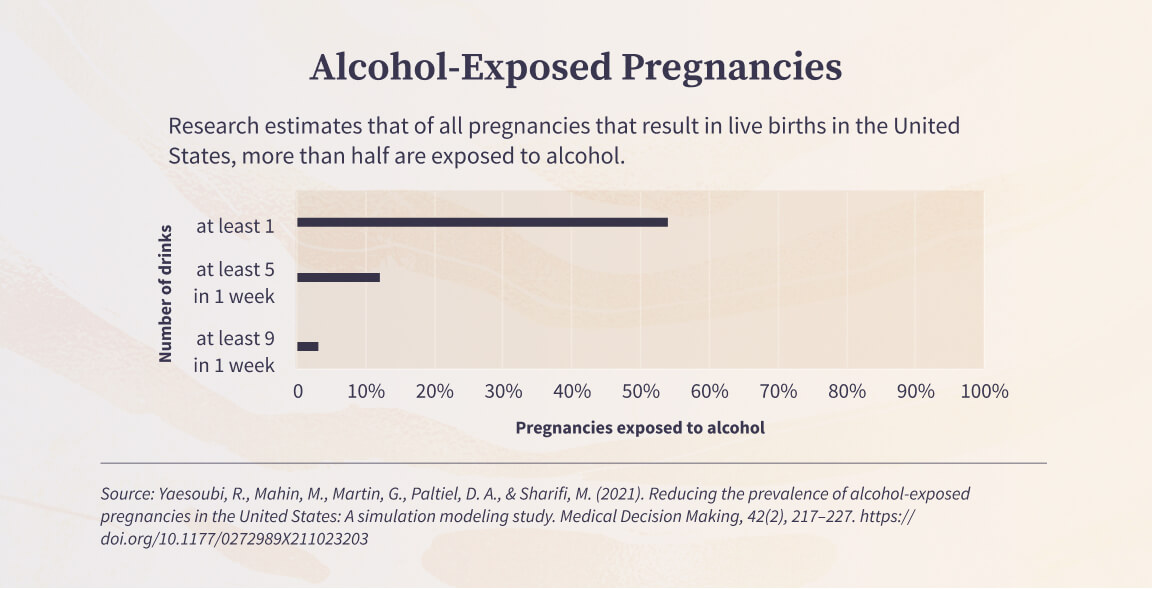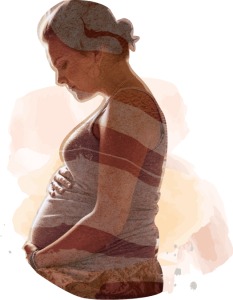The Risks of Drinking During Pregnancy and Fetal Alcohol Spectrum Disorders (FASDs)

Editor’s note: This article strives to use gender-inclusive language that encompasses all birthing parents. Some of the research and references in this piece are limited by noninclusive terms and only account for pregnant women, however, the takeaways can be applied to all birthing parents.
Drinking alcohol during pregnancy is the leading preventable cause of birth defects. However, 1 in 9 pregnant women reported drinking alcohol, and about 1 in 27 engaged in binge drinking, according to the U.S. Centers for Disease Control and Prevention.
Exposing fetuses to any amount of alcohol during pregnancy can put them at risk for developing fetal alcohol spectrum disorders (FASDs), a group of physical, behavioral and psychological conditions that can range from mild to severe. While some individuals may drink alcohol before they know they are pregnant, others may choose to drink without realizing the potential risk it poses to their child.
“People like things to be black and white,” said Catherine Ruhl, DNP, CNM, an Albuquerque-based nurse midwife. “Someone who had a couple of drinks when they were five weeks pregnant… there may never be anything that is seen in their child. But somebody who decides that wine is healthy and they want to have a drink at dinner if they want to have it, that they know best—we don’t know what that might mean for a fetus.”
The information below can help individuals understand the risks of drinking alcohol during pregnancy and find support for parenting children with FASDs.
Please note that this article is for informational purposes only. Individuals should consult their health care provider before following any of the information provided.
How Can Drinking Alcohol During Pregnancy Affect Development?
During pregnancy, there is no safe time to drink alcohol, no safe amount of alcohol to consume and no safe type of alcohol to drink, according to the CDC. Fetuses exposed to any amount of alcohol are at risk of developing birth defects and conditions that could affect them for the rest of their lives.
The precise effects of alcohol at any given moment during gestation are unclear because fetuses metabolize alcohol differently. That gray area—along with conflicting information or lack of knowledge about the specific risks of drinking during pregnancy—can cause some birthing parents to drink during pregnancy thinking they know best.
“There’s no question about the potential damage,” Ruhl said, adding it does not make sense that some pregnant people take chances around drinking alcohol when knowing the risks.
What Are Fetal Alcohol Spectrum Disorders (FASDs)?
Fetal alcohol spectrum disorders (FASDs) are a group of mild to severe conditions that occur in people exposed to alcohol before birth. FASDs are lifelong conditions that can affect attention, behavior, learning, social skills and physical development.
Symptoms of FASDs may include:
- Physical symptoms: low body weight; vision or hearing problems; problems with heart, kidneys and bones; small head size; short height; abnormal facial features.
- Behavioral/psychological symptoms: poor concentration, hyperactivity, poor memory, difficulty in school, intellectual or learning disabilities, speech and language delays.
- Alcohol-Related Birth Defects (ARBD): birth defects including problems with the heart, kidneys, bones, hearing or a combination thereof.
- Alcohol-Related Neurodevelopmental Disorder (ARND): difficulties including intellectual disabilities; behavior or learning problems; or trouble with math, memory, attention, judgment or impulse control.
- Fetal Alcohol Syndrome (FAS): condition that can include central nervous system problems; minor facial features; problems with learning, attention, memory, communication, vision or hearing; difficulty in school or cooperating with others; or a mix of these challenges.
- Neurobehavioral Disorder Associated with Prenatal Alcohol Exposure (ND-PAE): condition in which the birthing parent consumed more than 13 alcoholic drinks per month of pregnancy or more than two standard drinks in one sitting, leading to problems for the child with thinking and memory, behavior problems or difficulty with daily activities.
Alcohol and FASDs as Public Health Issues
The risks of drinking alcohol during pregnancy were not confirmed until the late 20th century, but public health and clinical guidelines around avoiding alcohol during pregnancy have held steady during the last several decades.
History of Recommendations
Around Alcohol and Pregnancy
Mid-1970s

Birth defects attributed to prenatal alcohol exposure were identified in the United States and France.
1973

Fetal alcohol syndrome (FAS) was defined based on facial anomalies, growth deficits and neurological problems in children that were linked to birthing parents drinking alcohol during pregnancy.
1977

The U.S. Food and Drug Administration and CDC recommend a two-drink-per-day limit for pregnant individuals.
1978

Fetal alcohol syndrome (FAS) was defined based on facial anomalies, growth deficits and neurological problems in children that were linked to birthing The broad term “fetal alcohol effects” (FAE) was introduced to cover the negative outcomes of alcohol-exposed pregnancies.
1981

U.S. Surgeon General Edward Brandt releases the recommendation that people should not consume any alcohol during pregnancy, a sentiment echoed by his successors as well as professional societies.
1987

Fetal alcohol syndrome (FAS) was defined based on facial anomalies, growth deficitAlcohol-related birth defects (ARBD) were defined as anatomical or functional defects associated with alcohol use during pregnancy. This term was later narrowed to refer to physical abnormalities associated with alcohol-exposed pregnancies.
2003

The National Task Force on Fetal Alcohol Syndrome and Fetal Alcohol Effect developed standardized guidelines for diagnosing FAS.
2004

The term “fetal alcohol spectrum disorders (FASDs)” was introduced to cover the range of conditions associated with fetal alcohol exposure, beyond FAS.
2005

A more refined set of guidelines for diagnosing FASDs was developed.
2016
CDC issues recommendation that women of reproductive age should avoid alcohol entirely when they are pregnant, attempting to conceive or could become pregnant. This warning received public backlash.
Sources:
- Warren, K. R. (2015 April). An Historically Hidden Health Problem: Alcohol and Pregnancy (PDF, 3.2 MB). National Institute on Alcohol Abuse and Alcoholism. Retrieved on April 14, 2022
- Seiler, N. K. (2016). Alcohol and pregnancy: CDC’s health advice and the legal rights of pregnant women.” Public Health Reports, 131(4), 623–627. https://doi.org/10.1177/0033354916662222
- Warren, K. R., Hewitt, B. G., & Thomas, J. D. Fetal alcohol spectrum disorders. Alcohol Research & Health, 34(1), 4–14. PMID:23580035
While FASDs can have severe implications for individual patients, they also have broader public health implications.
“FASD is an important public health and social issue associated with a large burden on society through the healthcare system, mental health and substance abuse system, foster care, criminal justice system and long-term disability care services,” according to the U.S. Department of Health and Human Services.
More broadly, binge drinking—quantified as consuming five or more standard drinks during one occasion for men or four or more standard drinks for women—continues to be a widespread problem among U.S. adults that contributes to serious injuries and multiple diseases.
“That was already known pre-COVID, that binge drinking was increasing among women,” Ruhl said. ”There has been some evidence out there that during COVID, drinking—especially among women, but among everybody—increased.”
But binge-drinking is not the only style of alcohol consumption that can threaten a fetus’s development.
“People tend to think either somebody is this incredibly risky drinker, alcoholic, or everybody else is someone that handles their social drinking,” Ruhl said. ”They don’t see that there is a continuum, especially when it comes to drinking and pregnancy, and they don’t see that alcohol has a significant risk.”
Alcohol-Exposed Pregnancies

About 54% of all pregnancies that result in live births are exposed to alcohol at least once, and some of those pregnancies are exposed to multiple alcoholic drinks, according to a study in Medical Decision Making. Researchers estimate that about 12% of pregnancies that result in live births are exposed to at least five drinks in one week, while 3% are exposed to at least nine drinks in a week.
Go to a tabular version of the “Alcohol-Exposed Pregnancies” at the bottom of the page.
Public Health Interventions for Drinking Alcohol During Pregnancy
Healthcare screenings for alcohol use in all patients and communication about its consequences can help deter alcohol use among the broader population, as well as people who are pregnant, Ruhl said. She has noticed nurses tend to focus more on marijuana use or illicit drug use rather than drinking alcohol during pregnancy.
“The challenge for us as professionals is not to try to be doing detective work in a punitive way but being supportive and finding out what’s really going on,” Ruhl said.
Asking birthing parents about alcohol use and following up with specific details about its risks to fetuses can help clinicians deter patients from drinking.
“It’s one thing to know that sort of catchy message about no safe time, amount or type,” Ruhl asid. “But … that idea of the fetus having a higher blood (alcohol) level than the mother when she drinks really sort of brings it home.”
Public health professionals can also help combat the issue, though they have to be careful to avoid condescending messaging. For example, the CDC came under fire after issuing a 2016 warning that women ages 15–44 should avoid alcohol altogether unless they were using contraception. However, unintended pregnancies account for 80% of pregnancies exposed to alcohol, according to research in Medical Decision Making.
But other public health interventions, such as the CDC’s CHOICES program—a model that works to curb risky drinking among women to reduce alcohol-exposed pregnancies—have the potential to help reduce alcohol-exposed pregnancies.
How to Navigate Pregnancy Tips
Beyond weeding through conflicting messages around the risks of drinking alcohol, it can generally be difficult for birthing parents to navigate pregnancy guidelines when they are bombarded with messaging about dos and don’ts.
“Isn’t it amazing what women are faced with, with even a normal healthy pregnancy?” Ruhl said.
She said it helps to own the anxiety that comes with pregnancy, and creating strategies to cope with that anxiety can help.
“It’s important to develop your strategies for managing anxiety about these kinds of debates and dilemmas during pregnancy,” Ruhl said. “You’ll be developing your strategies all along, and they’ll vary as a child ages.”

Questions to Ask Yourself to Manage Pregnancy Decision-Making
Self-reflection, as well as conversations with partners and clinicians, can help birthing parents make decisions around alcohol and navigate other decisions that affect their health and the health of their baby.
Birth parents can consider the following questions to help create strategies to soothe some of the worries that come with making decisions around their pregnancy:
- What are my values?
- What are my preferences?
- What are my boundaries?
- What will help me sleep at night?
- Who can help me with advice?
“Navigating pregnancy is just the training ground for navigating parenting,” Ruhl said. “It’s not like you’re going to get through pregnancy, and then [say], ‘Oh, good, I figured it all out.’”
Additional FASDs Resources
The resources below offer more information about FASDs for pregnant people and parents of children with FASDs.
Please note that this article is for informational purposes only. Individuals should consult their health care provider before following any of the information provided.
The following section contains tabular data from the graphics in this post.
Alcohol-Exposed Pregnancies
| Number of drinks | Pregnancies exposed to alcohol |
|---|---|
at least 1 | 54% |
at least 5 in 1 week | 12% |
at least 9 in 1 week | 3% |
